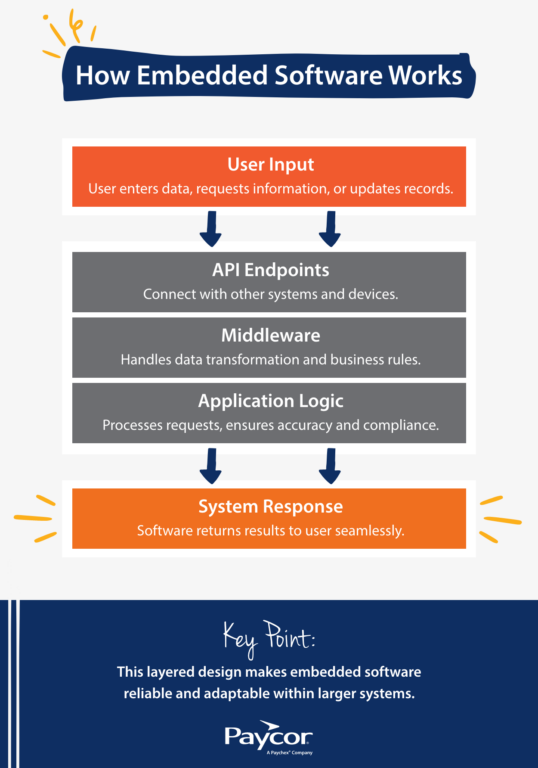When you offer industry software solutions, accounting services, HR consulting, or business management platforms, your customers inevitably ask, “Can you handle payroll too?” In order to offer full-service solutions, many consultants or software providers rely on embedded software.
Embedded software is the technology that makes seamless HCM integration possible, allowing you to provide powerful payroll and HR capabilities to your customers without building these complex systems yourself. It allows you to deliver integrated solutions that enhance your value proposition while generating new revenue streams.
Read on to learn more about how embedded software works, its benefits, and more.
What is Embedded Software?
Embedded software is specialized computer programming designed to perform specific functions within larger systems or devices while operating seamlessly behind the scenes. For Paycor’s embedded partners, this means human capital management (HCM) functionality that integrates directly into your existing platform or service offering, appearing as a native part of your solution rather than a separate third-party tool.
Unlike traditional software that requires users to switch between different applications, embedded software creates a unified experience. For example, when using Paycor embedded solutions, your customers interact with payroll, benefits, and HR management through your familiar interface, while Paycor’s robust infrastructure handles all the complex processing, compliance, and data management in the background.
Features of Embedded Software
Modern embedded software solutions offer several key characteristics that make them valuable for partner integrations and customer satisfaction:
- Seamless integration architecture: Embedded software connects with your existing systems through well-documented APIs and integration tools, ensuring data flows smoothly between your platform and the embedded tool.
- White-label capabilities: The embedded approach allows you to present embedded services under your own brand, maintaining consistency with your existing customer relationships. Your clients see your branding and interface, while the embedded infrastructure provides the underlying functionality.
- Built-in compliance management: Embedded software continuously monitors and applies current labor laws and tax regulations, reducing compliance risks for both you and your customers while ensuring consistent policy enforcement across all implementations.
- Scalable performance: Modern embedded software is designed to support varying volumes of users and data without compromising speed or reliability, making it ideal for growing businesses and evolving integration needs.
Embedded Software vs Embedded Systems
Understanding the difference between embedded software applications and embedded systems helps clarify how partner integrations work and what responsibilities fall to whom. An embedded system includes both the hardware and software components working together, while embedded software specifically refers to the programming that makes everything function.
Most modern business integrations focus on embedded software rather than complete embedded systems, since the software can run on existing infrastructure like web browsers, mobile devices, or cloud platforms without requiring specialized hardware installations.
How Embedded Software Works

Embedded software operates through a continuous cycle of data collection, processing, and response, all happening transparently within larger systems. When a user interacts with an application — whether entering time data, requesting information, or updating records — the embedded software processes their requests using pre-programmed business logic and rules, then returns the appropriate response.
The software includes multiple layers of functionality:
- API endpoints that enable communication with other systems
- Middleware that handles data transformation and business rules
- Application logic that ensures accurate processing and compliance
This layered architecture provides both reliability and flexibility.
The Different Types of Embedded Software
Different types of embedded software include the following:
Operating Systems
Embedded operating systems provide the foundation for complex business applications. These lightweight systems manage basic functions like memory allocation, task scheduling, and communication protocols. Embedded operating systems enable various devices and platforms to run reliably while maintaining security and performance standards.
An embedded operating system ensures services run efficiently whether users are accessing them through web browsers, mobile devices, or integrated business applications. This consistency is crucial for maintaining user satisfaction and reducing support requirements.
Firmware
Firmware represents the most fundamental level of embedded software, providing basic system functionality and hardware communication. In business applications, firmware ensures that underlying systems remain stable and secure, even as business requirements and user demands change.
While users don’t directly interact with firmware, its reliability affects the overall quality of software services. Stable firmware means fewer system issues, more predictable performance, and reduced support burdens.
Middleware
Middleware handles the integration between different systems and services. This software layer manages data translation, security protocols, and communication standards, ensuring information flows smoothly between different platforms.
Middleware provides the flexibility to customize how services appear within existing systems while maintaining data integrity and security standards. It also handles version updates and compatibility issues automatically, reducing ongoing maintenance requirements.
Applications
Application-level embedded software provides the user-facing functionality that people interact with daily. This includes processing interfaces, self-service portals, and management dashboards that appear within existing platforms.
Understanding application-level software helps with planning user experience design and training requirements. The software provides core functionality while allowing customization of presentation and workflow to match users’ needs and platform design standards.
Examples of Embedded Software
Learn how embedded software creates value across different industries and use cases with the following examples:
Business software integration
Accounting platforms often embed payroll, allowing users to process payroll directly within their familiar bookkeeping interface. The embedded software handles calculations, direct deposits, and compliance reporting while automatically updating accounting records.
Industry-specific platforms
Restaurant management systems that integrate embedded services can offer comprehensive business solutions including scheduling, time tracking, payroll, and specialized reporting. The embedded software adapts to industry-specific requirements like tip reporting and variable scheduling.
Professional services
Healthcare, legal, and professional service platforms that embed business management services can offer complete solutions. The embedded software handles the complexities of professional service operations while integrating with billing and client management systems.
Multi-location businesses
Organizations with multiple locations benefit from embedded services that provide consistent management across all sites while accommodating local requirements and regulations.
Consulting and advisory services
Service providers can offer clients comprehensive business solutions by embedding various software capabilities. The embedded software handles routine processing while consultants focus on strategic advice and relationship management.
Benefits of Using Embedded Software In HR

Benefits of using embedded software include:
- Expanded service capabilities: Embedded software allows organizations to offer comprehensive services without the massive investment required to build these capabilities internally.
- Reduced development costs: Rather than building complex systems from scratch, organizations can leverage proven infrastructure and expertise. This approach reduces development time, lowers risk, and allows faster time-to-market for new service offerings.
- Improved customer retention: Customers who use integrated services are less likely to switch providers, as the switching costs and complexity increase significantly. This integration creates stronger relationships and more predictable revenue streams.
- Enhanced user experience: Embedded software eliminates the need for users to manage multiple vendor relationships or learn different systems. This is a priority, as 2023 Capterra research shows 83% of HR employees had plans to consolidate software applications.
Best Practices for Implementing Embedded Software Systems
Successful implementation of embedded software requires careful planning and attention to both technical integration and business processes. Follow these best practices:
Define Objectives
Establish specific goals for embedded software implementation, including target outcomes, performance expectations, and integration timelines. Clear objectives guide technical decisions and help measure success throughout the implementation process.
Consider the User Experience
Design integration points that feel natural within existing platforms. Users should be able to access services without recognizing they’re using different underlying systems. This seamless experience reduces training requirements and improves adoption rates.
Establish Robust Data Security
Implement comprehensive security measures to protect sensitive data throughout the integration. This includes encryption protocols, access controls, and compliance with relevant data protection regulations.
Train Your Team
Develop training materials that help teams understand embedded systems and support user questions effectively. Well-trained staff can maximize the value of integration and identify opportunities for further improvement.
Monitor Performance
Continuously track system performance, user adoption, and satisfaction to identify optimization opportunities. Regular monitoring helps ensure embedded software continues to meet evolving business needs and user expectations.
How Paycor’s Embedded HCM Can Helps
Paycor offers embedded HCM services, including payroll and HR, that provide a low initial investment and quick revenue realization. By adding Paycor services to existing tech, clients can provide an all-in-one solution.
Paycor’s open platform seamlessly connects with other third-party systems. Our embedded solutions are designed to support partner success while delivering value to end customers through exceptional infrastructure and support.
Use Paycor Embedded Software for HCM
Paycor built a trusted HR and payroll solution so you don’t have to. Ready to increase revenue and grow customer retention with Paycor’s embedded solutions? Contact us today to get started.









